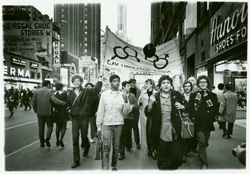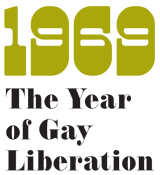Gay Liberation Front (GLF)
 |
Come Out!: A New Generation of Activists
Gay Liberation Front members marching on Times Square,
Fall 1969. Photograph by Diana Davies.
NYPL, Manuscripts and Archives Division, Diana Davies Papers. Copyright Diana
Davies.
Digital ID: 1582230
|
Mattachine worked hard to capitalize on the energy released by
the Stonewall Riots, holding public forums and demonstrations
to bring gays and lesbians into organized activism. These efforts
caught the attention of the generation that had come of age in
the civil rights and antiwar movements. However, this younger
generation had little patience for the tactics and politics of
their elders.
Michael Brown, a young veteran of the New Left, contacted Mattachine
president Dick Leitsch after reading his position paper on Stonewall, "The
Hairpin Drop Heard Around the World," and with Leitsch's
support he created the Mattachine Action Committee. But the new
committee soon seceded from Mattachine, rechristening themselves
the Gay Liberation Front (GLF). GLF members openly claimed the
word "Gay," which had been avoided by the previous generation
of gay and lesbian activists in favor of cryptic, inoffensive
names: Mattachine, Bilitis, Janus. They demanded liberation in
the spirit of the national-liberation and anti-capitalist struggles
around the world.
GLF meetings were run by consensus. While this was not the
most efficient method of decision-making, it created an opportunity
for dialogue that transformed its members. The core activists
of GLF — who included Michael Brown, Martha Shelley, Lois
Hart, Bob Martin, Marty Robinson, Karla Jay, and Bob Kohler among
many others — organized marches on
Time magazine
and
The Village Voice, fund-raising dances,
consciousness-raising groups, and radical study groups, and
published their own newspaper,
Come Out!, out of the
Alternate U. on Sixth Avenue and 14th Street. GLF eventually became
a network of semi-autonomous cells. Groups such as the Red Butterfly
Cell, the 28th of June Cell, the Planned Non-Parenthood Cell,
the Gay Commandoes, and the Aquarius Cell each pursued a specialized
agenda, free from the demands of establishing an overall GLF consensus.
GLF quickly became the incubator of the new gay and lesbian mass
political movement. Although many activists moved on to create
more focused gay and lesbian organizations, GLF transformed the
consciousness of everyone it touched.

